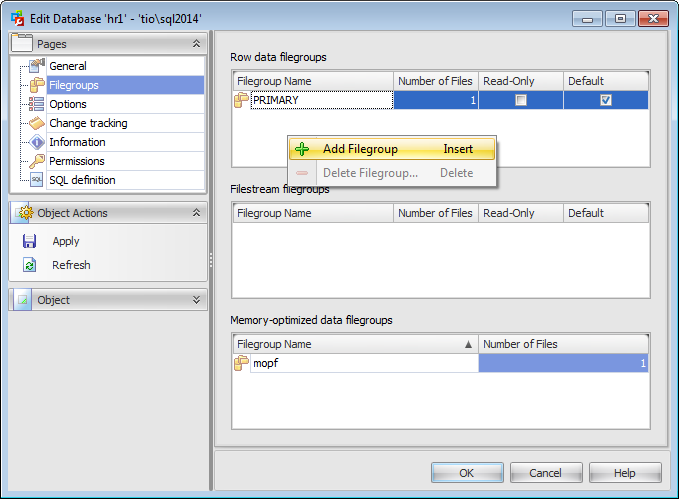Online Documentation for SQL Administrator for SQL Server
Managing filegroups
Database objects and files can be grouped together in filegroups for allocation and administration purposes.
Using the popup menu you can ![]() Add or
Add or ![]() Delete filegroups.
Delete filegroups.

All data files are stored in filegroups:
- PRIMARY: the filegroup that contains the primary file. All system tables are allocated to the primary filegroup.
- User-defined: any filegroup that is specifically created by the user when first creating or later altering the database.
Filegroup types are separated into Row data filegroups and Filestream filegroups. Row data filegroups contain regular data and log files. Filestream filegroups contain Filestream data files. These data files store information about how binary large object (BLOB) data is stored on the file system when you are using Filestream storage. The options are the same for both types of filegroups.
Read Only
Specifies that the filegroup is read-only. Updates to objects that reside in this filegroup are not allowed. The PRIMARY filegroup cannot be marked read-only.
Default
When objects are created in the database without specifying to which filegroup they belong, they are assigned to the default filegroup. At any time, exactly one filegroup is designated as the default filegroup. The files in the default filegroup must be large enough to hold any new objects not allocated to other filegroups. Initially, the PRIMARY filegroup is the default filegroup.
For SQL Server 2014 databases Memory-optimized data filegroups area is available for editing as well.
You need to specify the name of the memory-optimized data filegroup of the database in the Filegroup Name column.
The number of files is increased automatically after adding memory-optimized data files on the General tab.
All these filegroup parameters are edited directly in the corresponding fields.



































































